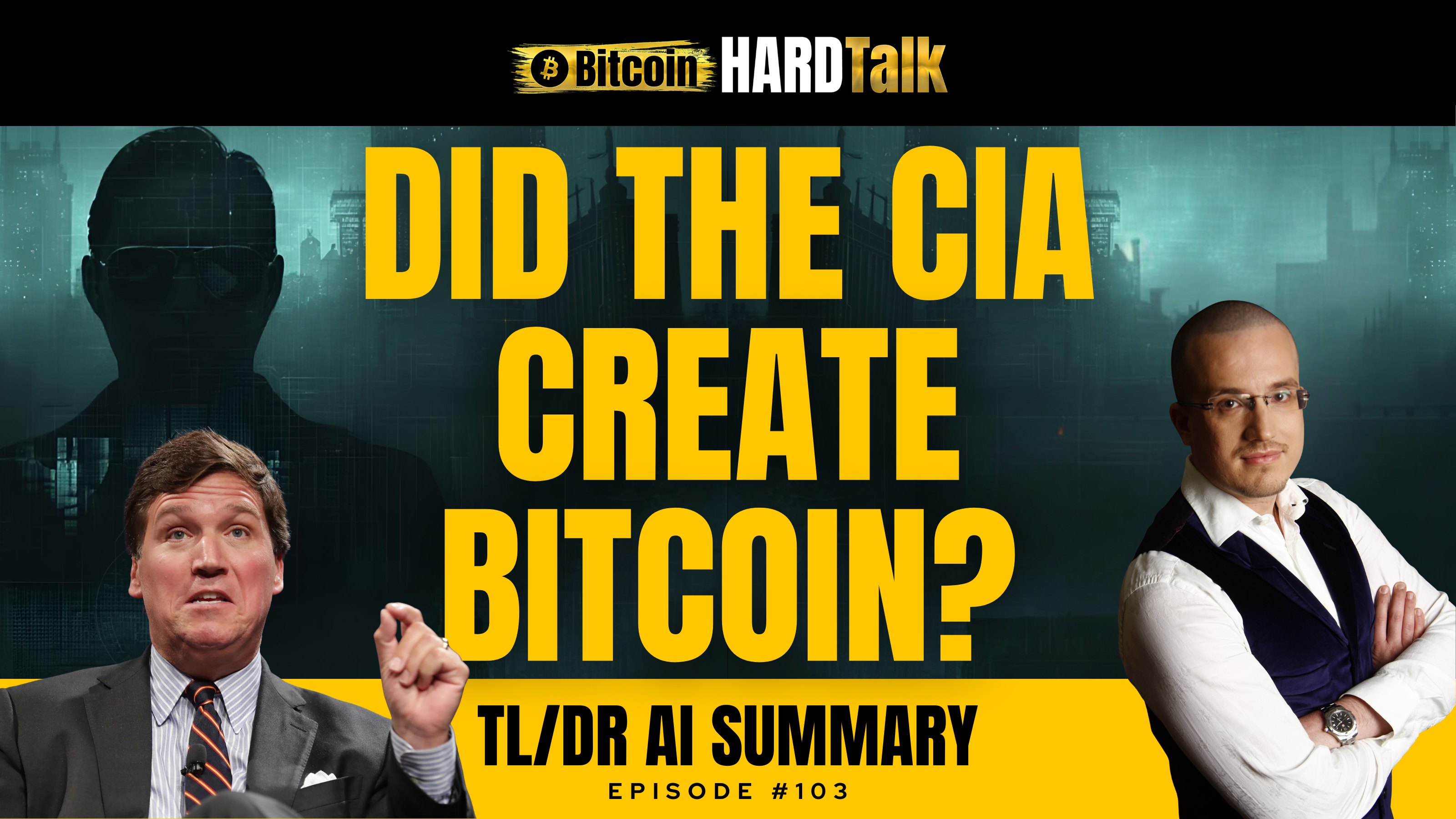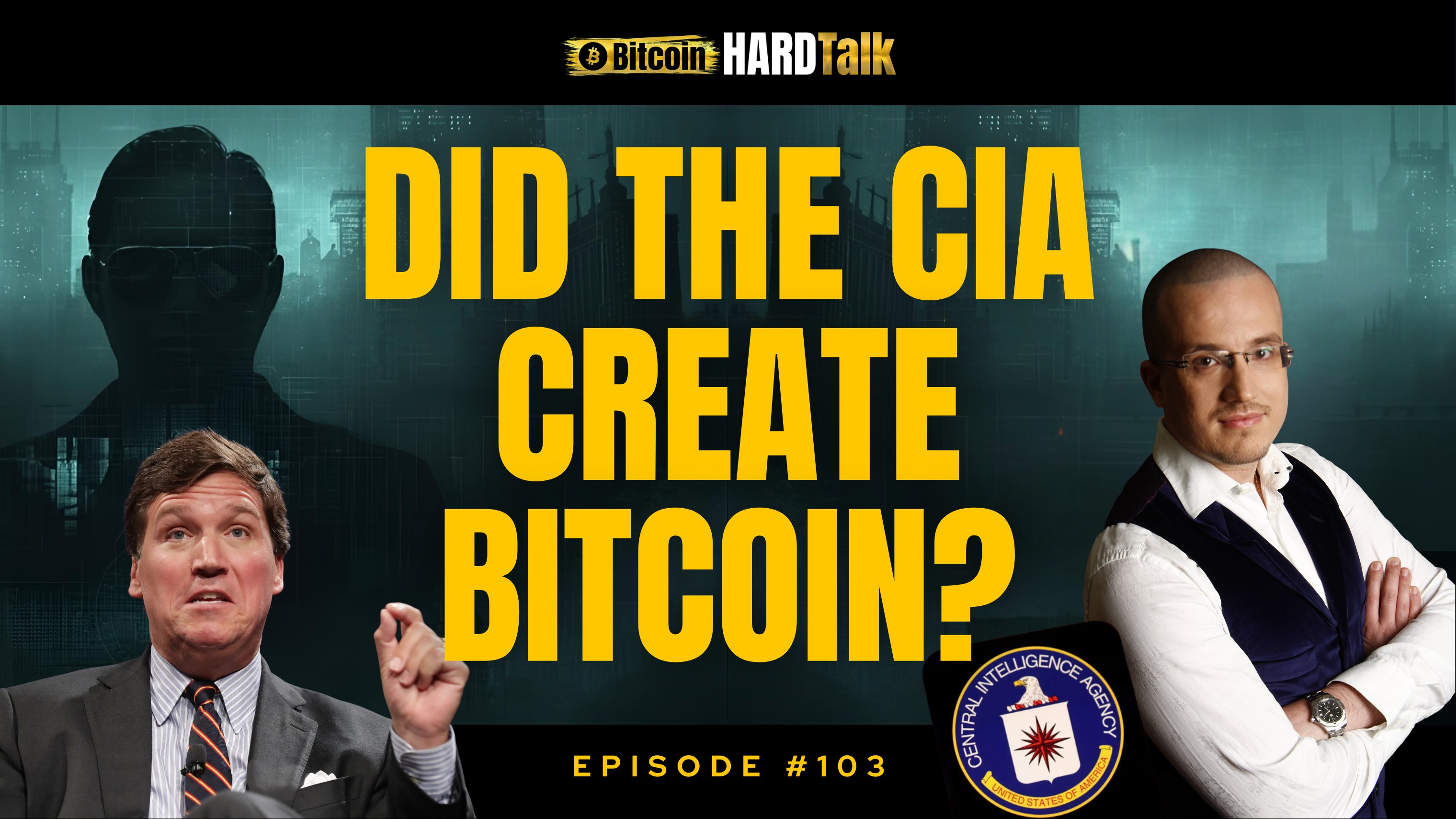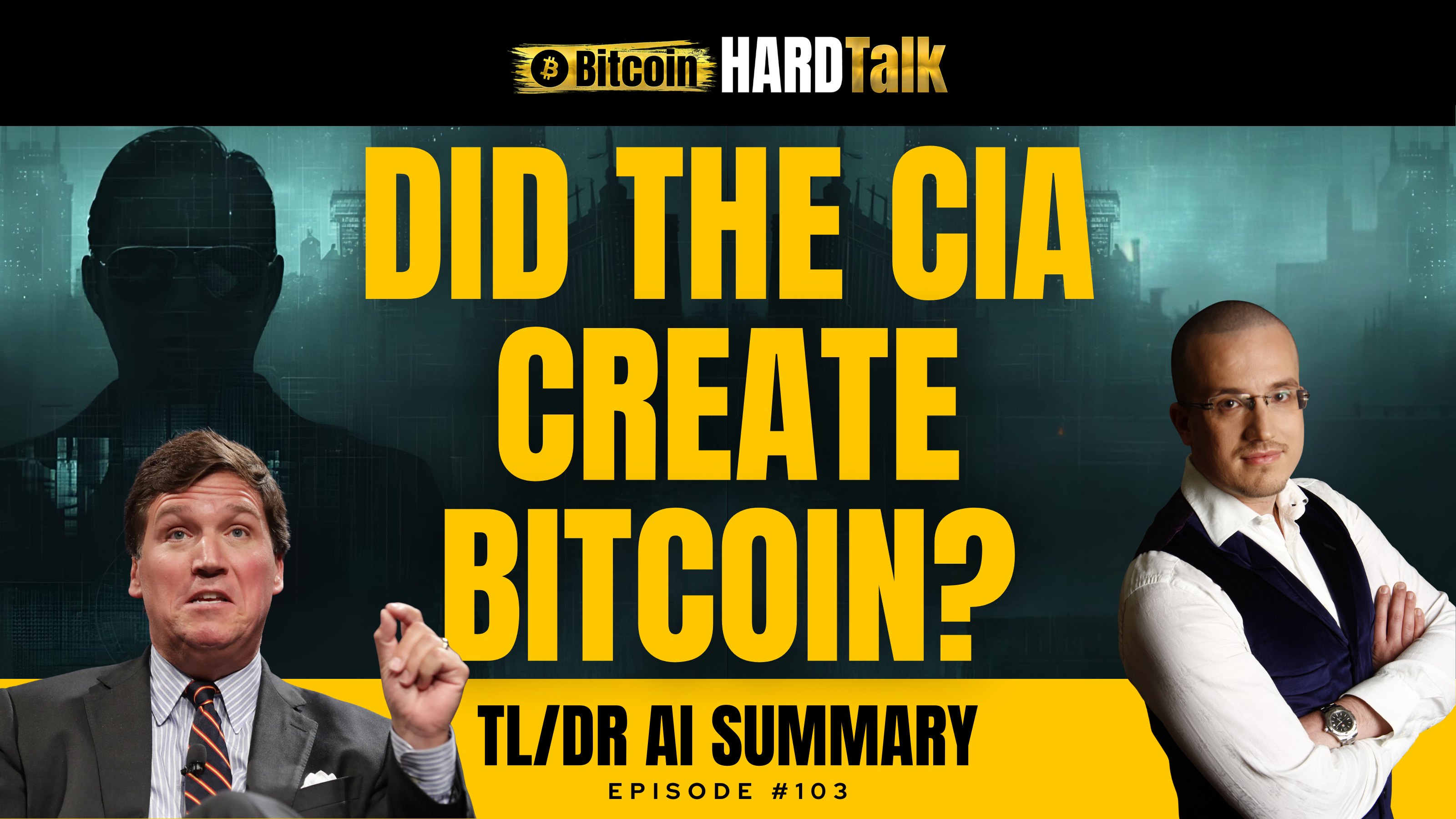Was Bitcoin a CIA Project? The Hidden Origins of Satoshi Nakamoto | #BitcoinHardTalk Episode 103
Oct 24, 2025TLDR — No Time For The Full Video?
- Click here to listen to the TLDR Ai Audio Overview (35:04)
- Click here to watch the TLDR Ai Summary whiteboard animation (6:47).
TLDR Ai Audio Overview (35:04) | Was Bitcoin a CIA Project? The Hidden Origins of Satoshi Nakamoto

TLDR Ai Whiteboard Animation Video (6:47) | Was Bitcoin a CIA Project? The Hidden Origins of Satoshi Nakamoto

Hey-Hey, Bitcoin Wealth Builders!
For 14 years now, I have been asked this question constantly: Did the CIA create Bitcoin? And who is Satoshi Nakamoto? It is one of the most persistent and frequently asked questions I receive,.
This debate was recently flung back into the viral sphere when Tucker Carlson stated he "wouldn’t buy Bitcoin because it was created by the CIA". Since that comment, our Episode 103 has exploded, proving just how much this question matters right now.
As an early investor who bought Bitcoin at $3 in 2011, spoke at the first Bitcoin conference in Prague, and wrote the first published book in the world to include Bitcoin, Bank to the Future, I wanted to use the platform of BitcoinHardTalk to create the single, comprehensive, definitive resource to settle this debate once and for all,.
This blog is the essential, detailed TLDR to the almost three-hour deep dive we conducted, examining the historical connections between Bitcoin, intelligence agencies, and the underlying monetary corruption that birthed the whole movement.
1. The Plausibility: The CIA Theory Has Deep Roots
To dismiss the idea of intelligence connections outright would be intellectually dishonest. If you follow the history of cryptography and the people who developed these systems, intelligence fingerprints are highly plausible.The Smoking Gun Name: "Central Intelligence"
Let’s start with the name itself: Satoshi Nakamoto. Richard Werner, whom I knew from the early monetary reform movement, argued that the name means "Central Intelligence," suggesting a deliberate hint from secret service agencies who "like to be talked about".
This isn't a stretch if you use the traditional Japanese format (Nakamoto Satoshi): Nakamoto means "Central Origin," while Satoshi translates to "Wisdom" or "Intelligence".
Intelligence Fingerprints on the Code
Furthermore, integral parts of Bitcoin's technology were demonstrably created by intelligence bodies:
- SHA 256: The hashing algorithm used in Bitcoin was created by the NSA.
- NSA Sponsorship: A paper was sponsored by the NSA regarding a peer-to-peer cash system, written by a Natoshi Sakamoto.
- Cryptography as Munitions: Historically, cryptography was classified as part of the Munitions Act after WWII, highlighting its military significance.
The Centralized Precursors and the Trojan Horse
Mark Yusko presented a theory aligning with the idea that Bitcoin was meant to be a centralized Trojan Horse. He argued that if you saw the inevitable "endgame of devaluation" for the global reserve currency, you might create a "cool asset" like Bitcoin, get everyone to swap their "worthless fiat" into it, and then "seize it all out the back door".
This plot aligns with the history of early digital currency, which may trace back to the Jewish mob led by Meyer Lansky, whom I call the "idiot savant of Bitcoin." Lansky realized the fiat system was corruptible and sought a private peer-to-peer network to stay ahead,,. This endeavour led to the funding and creation of David Chaum's DigiCash—a centralized precursor to Bitcoin that ultimately failed in 1998.
The initial intent of these early, intelligence-connected concepts was simple: centralization and control, paving the way for the surveillance state and CBDCs we see today.
2. The Great Escape: Why the Origins Don't Matter
The fundamental conclusion, regardless of Bitcoin's technical lineage, is that the system escaped.
Even if the technology was originally funded by the POWN (Proof of Weapons Network)—the financial-military industrial complex—the combination of open-source code and Proof of Work (PoW) made it impossible to control, defying any original centralization intent.
As a venture partner, Scott Stornetta (cited in the white paper), confirmed, the way people think about a backdoor is impossible with Bitcoin because of the air gap.
The Anti-Fragile Network
Bitcoin is an adaptive biological system. Its design ensures resistance:
- Open Source Code: Bitcoin's proposals are transparently put forward to a GitHub repository of developers.
- Decentralized Mining: It exists on the largest, most distributed supercomputer ever, with hash power spread across hostile nations like China, the US, Russia, and Iran,. The game theory ensures a 51% attack will never happen, because the moment a centralized entity achieves it, the value would instantly drop to zero, eliminating the economic incentive.
- Self-Verification: Anyone can run a node and verify their own transactions, even connecting via satellite.
The fact that it survived and thrived—going from $3 to its current price—was the real "miracle",. It is this robust, leaderless architecture that makes Bitcoin the ultimate resistance against the Proof of Weapons Network.
3. The Identity of Satoshi Nakamoto
If the system escaped, does the identity of its creator matter? The short answer is no, but the theories are compelling.
The Case for Len Sassaman
We dove deep into the most compelling theory: that Len Sassaman is Satoshi Nakamoto. Sassaman was a PhD candidate of David Chaum, placing him at the epicentre of cryptography,. The evidence includes:
- Expertise and Timing: Sassaman combined Adam Back’s Proof of Work with DigiCash’s mechanisms, recognizing that timestamping was the single most important part. His background as an American living in Belgium explains the British English spellings ("grey," "flat") in Satoshi’s posts.
- The Vanishing Act: His tragic suicide in 2011 aligns closely with when Satoshi Nakamoto permanently ceased all communication online.
The Unmoved Stash and Public Dismissal
However, the case is deeply conflicted. Sassaman was publicly dismissive of Bitcoin on Twitter, calling it "bunk" and "fail," which makes it difficult to accept that he spent three years secretly building it.
Furthermore, the central conflict remains: The Unmoved Stash. Satoshi's presumed 1 million Bitcoin stash remains unmoved. If Sassaman died in 2011, why didn't his wife (an accomplished hacker herself) access the funds to support projects they cared about?
The Conclusion on Identity: We still do not know who Satoshi is, and it does not matter. Even if those keys were moved, the primary function of Bitcoin as a secure, anti-fragile network remains intact. All a seller could do is create cheap Bitcoin for those who are accumulating.
4. The Current Danger: The Proof of Weapons Network (POWN) Attack
The real risk today is not some historical CIA plot, but the present-day scheme by the POWN—the financial industrial complex—to centralize Bitcoin using financial weapons of mass destruction.
They are actively building a "centralization honeypot" through Wall Street:
- BlackRock ETFs: BlackRock (the modern "American version of the East India Company") wants you to surrender your Bitcoin into their custody via ETFs. This creates a centralized pool of Bitcoin, allowing them to consolidate power and assets.
- JP Morgan Leverage: JP Morgan is issuing loans against Bitcoin ETFs. They want you to borrow against your Bitcoin using leverage so they can swipe all your Bitcoin during engineered flash crashes and liquidations if you lack margin.
- The Surveillance Alternative: Simultaneously, the crypto lobby (Tether, Coinbase, Ripple Labs) is funding White House activities to usher in the alternative: a digital surveillance state through stablecoins and Central Bank Digital Currencies (CBDCs).
This is how the POWN extracts wealth and consolidates power, using mechanisms that were "beta tested" during events like the Celsius bankruptcy, which had deep-state and Misaad connections.
Your Only Defense: The Peaceful Boycott
The answer is clear: Bitcoin is resistant to centralization because it escaped the original mandate. Your job is to resist the current centralization mandate.
The only strategy to beat the Proof of Weapons Network is through the Peaceful Boycott.
- Self-Custody is King: Hold your Bitcoin in self-custody to escape financial surveillance and ensure sovereignty. This allows you to own your own money and spend it without permission.
- No Leverage, No Yield: Do not borrow against it, and do not use exchanges or centralized platforms to chase yield. Leverage is their primary tool to seize your Bitcoin.
- Accumulate Consistently: Ignore the price and commit to accumulating more Bitcoin this month than the last month.
Those who have done this consistently for years have outperformed the entire collective intelligence of the proof of weapons network. This is your protection as we navigate "200 years of change in the next 5 years".
Watch the Video (YouTube)
For the full, detailed history, geopolitical analysis, and comprehensive breakdown:
- Watch the YouTube Replay: The replay is available on YouTube.
- Listen on the Move: The Podcast is available on Spotify and Apple Podcasts.
- TLDR AI Summary: A quick-hit, bullet-point summary is also available.
Peace,
Simon Dixon 🚀
Bitcoin OG | Investor | Geo-Political & Financial Analyst
Disclaimer
This blog post, "Was Bitcoin a CIA Project? The Hidden Origins of Satoshi Nakamoto | #BitcoinHardTalk Episode 103," presents comprehensive geopolitical and geofinancial analysis, commentary, and education, drawing on the author, Simon Dixon's, personal experience as an early Bitcoin investor (buying at $3 in 2011) and former professional in the financial industry . All opinions, assessments, and interpretations presented herein belong solely to Simon Dixon, including the critical analysis of the Proof of Weapons Network (POWN) and highly detailed, speculative theories regarding Bitcoin's origins and the identity of Satoshi Nakamoto . This content is provided strictly for informational and educational purposes only and must not be construed as financial advice, investment advice, legal counsel, or tax guidance . Readers must recognize that asset prices, including Bitcoin and gold, are inherently volatile, and all investment carries risk ; therefore, individuals should seek independent professional advice before making any financial decisions .





